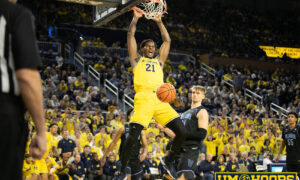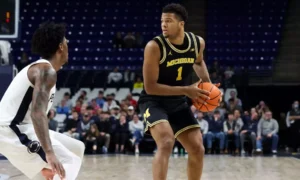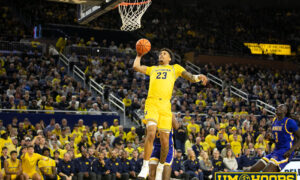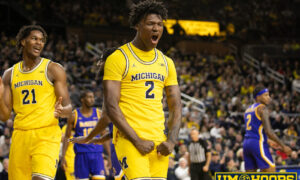With the official start of practice in September, UM Hoops and Inside the Hall have partnered to bring you our annual preseason breakdown of the top players in the Big Ten for the 13th straight season.
The series is broken into seven parts and we continue with our seventh and final installment of players 5-1 for the 2025-26 season: (Previously: 6-10, 11-15, 16-20, 21-25, 26-30, 31-40)
5. Donovan Dent, UCLA (6-foot-2, guard, senior)
Why he could outperform this ranking: Mick Cronin scored a major upgrade for his backcourt with the addition of Dent, who entered the transfer portal following a brilliant junior season at New Mexico.
A native of Riverside, California, Dent led the Lobos to the 2025 NCAA Tournament and averaged 20.4 points, 6.4 assists, 2.3 rebounds and 1.4 steals in 35.3 minutes per game. He shot 40.9 percent on 3s and 78.4 percent from the free-throw line. Dent amassed 16 KenPom Game MVPs, which tied him for sixth nationally with Yaxel Lendeborg.
His assist rate of 35.8 percent ranked 23rd nationally and he got to the line 227 times (6.7 attempts per game). An elite playmaker in ball screen situations – he created the fourth most points in the country out of ball screens according to Synergy – Dent excels at reading defenses and taking what he’s given. He’s crafty with the ball and should benefit from a move to a UCLA roster that will surround him with more talent than he had in Albuquerque.
Why he could underperform this ranking: Dent will have to make the transition from playing in one of the most uptempo offenses in the country to a more deliberate pace at UCLA. The Lobos ranked seventh in adjusted tempo last season and the Bruins were 312th.
He also struggled with taking care of the ball against some of the nation’s top teams last season. In five games against UCLA, St. John’s, USC, Marquette and Michigan State, Dent committed 5.4 turnovers per game.
As a smaller guard, he’ll have to prove he can maintain his efficiency at the rim against more length and athleticism. According to Synergy, 51 percent of his field goal attempts last season came at the rim and he shot 58 percent. If that number falls, Dent could take a step back in his final season.
4. Bennett Stirtz, Iowa (6-foot-4, guard, senior)
Why he could outperform this ranking: Stirtz might be the most coveted pro prospect in the conference. The 6-foot-4 Drake transfer has followed new Iowa coach Ben McCollum on his journey from Northwest Missouri State to Drake and now Iowa City.
For all intents and purposes, Stirtz is the show for Iowa. He played almost every minute for Drake last season, leading the country by playing 98.8 percent of available minutes, and he pulls the strings for McCollum’s slow-paced but intricate ball screen offense.
Stirtz scores efficiently – 54.5 percent on twos and 39.6 on threes – and finished 35th nationally in assist rate. He’s one of the best ball screen maestros in college basketball and ended the year ranked in the 98th percentile in ball screen volume and 82nd percentile in scoring efficiency (including passes), according to Synergy.
Stirtz’s 19 KenPom MVP honors last season were tied for the second most in the country, and the continuity and understanding with McCollum should help his transition to the Big Ten in a way that doesn’t apply to other high-profile additions in the league.
Why he could underperform this ranking: While the continuity helps, the jump from the Missouri Valley to the Big Ten is significant. Stirtz proved that he can make the leap from Division II to Division I, but this might be an even more arduous task.
He also doesn’t have quite the same caliber of starting cast as some of the other names in the top 5 to 10 spots on the list, which could be a differentiator by year’s end.
3. Yaxel Lendeborg, Michigan (6-foot-9, forward, graduate senior)
Why he could outperform this ranking: Lendeborg was one of the most productive players in college basketball last season, stuffing the box score with 17.7 points, 11.4 rebounds, and 4.2 assists per game.
He slots in nicely to Dusty May’s roster as a potential replacement for Danny Wolf, who served as a point power forward a year ago. Lendeborg opted to withdraw from the NBA Draft and attend Michigan, despite being projected by many as a late first-round pick.
At 6-foot-9 with terrific length, Lendeborg produces with his transition scoring, rebounding, passing and defensive playmaking. His upside is enormous – he even had a 30-point, 20-rebound, 8-assist, 5-block, 4-steal game in the AAC tournament – and he should receive every opportunity to be a focal point of Michigan’s scheme.
Why he could underperform this ranking: Lendeborg’s talent is impressive, but he faces a significant transition, too. The American to the Big Ten is a leap, and Lendeborg will be playing in a very different system on offense and defense than he did at UAB.
He’ll have to prove that he can elevate his elite box score production to the next level and adapt to the physical nature of the Big Ten. His 3-point shooting is another swing skill to watch. Lendeborg shot 36.2 percent from deep last season, but attempted just 15 percent of his shots from 3-point range. He’s likely to take more threes in Ann Arbor – every one of May’s incoming transfers increased their 3-point volume last season – and will need to prove his accuracy on higher volume.
2.Trey Kaufman-Renn, Purdue (6-foot-9, big, senior)
Why he could outperform this ranking: Unlike 3, 4 and 5 on our list, Kaufman-Renn has done it in the Big Ten. He’s not a talented player learning the ropes of a new league; he’s a returning, proven 20.1-point and 6.5-rebound-per-game scorer. He’s not making a transition to a new coach, system, league, or program; he’s returning for his fourth season in the same program while playing with the best point guard in the country.
It’s near-impossible to argue with Kaufman-Renn’s offensive production. He shot 59.7 percent on twos and was one of the country’s best ball screen bigs, especially with his feel and understanding in the short rolls, where he has one of the best floaters in the country – among all players, not just from big men. He has proven himself to be the perfect complement to Braden Smith at the guard spot, and together, the duo is one of the best two-man groups in the country.
Why he could underperform this ranking: While he’s probably one of the highest-floor players in the country, there’s an argument that some other names on this list have more upside to leapfrog him as the season wears on.
As great as Kaufman-Renn is on offense, his defensive impact is limited. He’s not a great rim protector and anchored the No. 332-ranked 2-point defense in college basketball last season.
Purdue has brought along reinforcements to remedy that problem with Oscar Cluff incoming and Daniel Jacobsen returning from injury, and their presence could mean that Kaufman-Renn’s statistical outputs dip a bit, even if Purdue improves as a unit.
1. Braden Smith, Purdue (6-foot, guard, senior)
Why he could outperform this ranking: There’s no debating Braden Smith is the top player in the Big Ten entering the 2025-26 season.
The former 3-star point guard was the Big Ten Player of the Year last season and led the Boilermakers to a 24-12 record and a Sweet Sixteen appearance. There are no holes in Smith’s offensive game. He averaged 15.8 points and 8.7 assists last season while shooting 38.1 percent from deep and 83.3 percent from the free-throw line. According to Synergy, Smith finished second in the country in points per game created out of the ball screen. He had the second-best assist rate in the country.
Smith also stuffs the stat sheet with rebounds – 4.5 per game – and steals with 2.2 per game while playing 37 minutes per night. Given that he’s improved each season in West Lafayette under Matt Painter, there’s no reason not to expect yet another level from Smith for his final act.
Why he could underperform this ranking: Winning back-to-back Big Ten Player of the Year awards is a difficult task. Only four players – Jim Jackson, Mateen Cleaves, Luka Garza and Zach Edey – have won the award twice.
As last season’s player of the year, Smith will be more scrutinized than any other player in the league this season as Purdue is once again among the league favorites. Any slip in his individual production or Purdue’s team performance could open the door for another player to challenge him for the award.

Notable Replies
Discuss the Article
58 more replies









BlueRev1
Anyone adding up player values as a team? (Meant to post here/sorry double post)… I know it doesn’t work this way but, UM with 55 points McKenney Hon Men, 64 points Cadea 36, 72 points Mara 28, 81 points Johnson 19, 97 points Yax 3 = 369 total points (not including rest of team). Wonder how that comps to conference but don’t want to take time. Obviously Purdue gonna have lotsa points with top two players
umhoops
I wouldn’t suggest doing that, but here are the results (ignoring honorable mention because there are a ton of guys who could fall into that).
Copied you and just did points as the inverse of ranking, essentially (41-ranking) … 1 point for 40th and 40 points for 1st.
DMB_Dad
I am not sure who I would move ahead of him but it seems like TKR is a little high to me. He is obviously a really good player but certainly has some flaws to be the 2nd best player in the conference. He is a poor rebounder and defender. While he is very good offensively, I would think the 2nd best player in a conference would have added something else to his game like a 3 point shot.
Is he thought to be a legit NBA prospect next year?
umhoops
Eh, he averged 20 and 7 last year. He put up a 118.1 ORtg on 31.1% usage and plays for the Big Ten favorites.
I don’t think it really matters if he’s an NBA prospect or not, he’s going to be dominant.
DMB_Dad
This is more of a high level thought about the rankings. He is elite offensively, and mediocre defensively. Should that be enough to make him the second best player in the league? Don’t know who I would put above him, considering the next three players are transfers which leads to some questions.
I agree the NBA prospect part is irrelevant to his conference ranking. I was just genuinely curious.